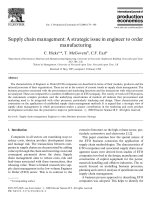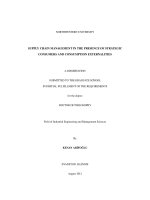Information shared postponement strategies in supply chain management
Bạn đang xem bản rút gọn của tài liệu. Xem và tải ngay bản đầy đủ của tài liệu tại đây (851.48 KB, 222 trang )
INFORMATION-SHARED POSTPONEMENT
STRATEGIES IN SUPPLY CHAIN MANAGEMENT
ZHANG, CHENG
(B.Sc. Fudan University, China)
A THESIS SUBMITTED
FOR THE DEGREE OF DOCTOR OF PHILOSOPHY
DEPARTMENT OF INFORMATION SYSTEMS
NATIONAL UNIVERSITY OF SINGAPORE
2004
i
ACKNOWLEDGEMENTS
The completion of this thesis owes to many people to whom I would like to express my
heartfelt appreciation. They gave me sincere help and encouragement along the way. First
of all, I would like to express my sincere appreciation to my supervisor, Dr. Tan Gek
Woo, for her insightful guidance and generous help throughout my four-year
postgraduate study. She has spent much time and effort on reviewing various revisions of
this thesis, and has lightened me in writing and organizing this thesis. Without her
direction and help, this thesis would never be possible. From her, I learnt not only the
knowledge in my research area, but also the principle of being good in life. The spiritual
invaluable fortune inherited from her will definitely benefit my whole life.
I would also like to take this opportunity to thank Dr. Wei Kwok Kee, Dr. Chan Hock
Chuan, Dr. Teo Hock Hai, Dr. Pan Shan Ling, Dr. Tan Cheng Yian and Dr. Hui Kai Lung
for all their guidance and caring in my research during the four-year study in NUS. Also,
I thank the Department of Information System of NUS for giving me an opportunity to
study in Singapore, as well as the financial support. Furthermore, I like to thank Madam
Loo Line Fong in SOC Graduate Office who is always patient with my iterative questions
and troubles.
I am also grateful to all my good friends I met in Singapore. They are Zeng Xiao Hua and
her husband, Wang Bei and her husband, Wang Xiao Ying and her husband, Cui Yan and
ii
her husband, Cong Cao and his wife, Lin Wei Dong and his wife, another Zhang Cheng
(☺) and his wife, Han Bin Hua, Li Yan, Wan Kok Cheung, Li Hui Xian, Zhou Yin, Cai
Shun, Xu Heng, Meng Zhao Li, Yang Fan, Yi Lan, Zhao Kai Di and Zhu Xiao Tian, etc.
It is my pleasure to meet them here.
It is good luck to meet my girl friend, Ms. Zhou YouYou, here. We have spent four years
together in NUS, sharing everyday happiness, pain, ease, and anxiety with each other.
She is such a smart, nice and naive girl who is worthy of my whole life of care. Without
her continuous encouragement, I could not finish this boring thesis writing so
successfully and quickly.
I give my deepest thanks to my parents for what they have done for me throughout the 27
years. Their unconditional love is always my ultimate source of strength. I owe too much
to they. I would like to dedicate this thesis to my parents, as a small token of my gratitude.
ZC
March 2004
iii
TABLE OF CONTENT
ACKNOWLEDGEMENTS i
TABLE OF CONTENT iii
SUMMARY v
LIST OF TABLES viii
LIST OF FIGURES x
CHAPTER 1 INTRODUCTION 11
CHAPTER 2 LITERATURE REVIEW 18
2.1. The Concept Of Supply Chain And Supply Chain Management 18
2.2. Challenges In SCM And Suggested Solutions 20
2.3. Postponement Strategies 28
2.3.1. Types of postponement strategies 30
2.3.2. Value of postponement strategies 36
2.4. Information Sharing Strategies 47
2.4.1. Order information sharing 50
2.4.2. Types of information sharing strategies 53
CHAPTER 3 RESEARCH QUESTIONS AND METHODOLOGY 72
3.1. Supply Chain Model 72
3.2. Supply Chain Performance Measurements 77
3.2.1. Service measurements 78
3.2.2. Cost measurements 81
3.3. Research Questions 85
3.3.1. The impact of information on postponement strategies 85
3.3.2. Sensitivity analysis 94
3.4. The Methodology 100
3.4.1. The concept of simulation 101
3.4.2. The value of simulation in supply chain study 105
CHAPTER 4 EXPERIMENT DESIGN AND MODEL VALIDATION 108
4.1. General Settings And Assumptions For The Experiments 108
4.2. Experiment Design For A Supply Chain Network 110
4.2.1. Algorithm logics in simulation program 114
4.3. Experiment Design For Postponement Strategies 117
4.3.1. Combined postponement design 119
4.4. Experiment Design For Information Sharing Strategies 122
4.5. Validation Of The Simulation Models 125
4.5.1. Simulation tool: GPSS/World 126
4.5.2. Statistical analysis for model validity 127
4.5.3. Statistical analysis for steady-state parameters 129
CHAPTER 5 RESULTS ANALYSIS 132
5.1. Service And Cost performances 134
5.1.1. General observations 134
5.1.2. Detailed performances 145
iv
5.2. Sensitivity Analysis 155
5.2.1. The impact of demand correlation across time 156
5.2.2. The impact of demand variance 159
5.2.3. The impact of production leadtime 161
5.2.4. The impact of service level 163
5.3. Extended Analysis Of Combined Postponement Cases 166
5.4. Summary And Implication 169
5.4.1. Summary 170
5.4.2. Discussion and implication 173
5.4.3. Strength and limitation of the simulation system 182
CHAPTER 6 CONCLUSION AND FUTURE DIRECTION 185
6.1. Conclusion 185
6.2. Future Direction 188
REFERENCES: 191
APPENDICES: 214
v
SUMMARY
Postponement strategy is one of the effective strategies for improving a supply chain’s
responsiveness to increasing product variations and shortening product life cycle. Over
time, the scope and application of postponement has expanded to various aspects in the
supply chain. Recent research shows that information sharing strategy plays an important
role on postponement implementation. From a supply chain dynamic model developed in
this study, it is also easy to find the significant dynamic interaction between information
sharing strategy and postponement strategy in a context of supply chain management.
However in research detailed cost-benefit analyses on various forms of postponement
strategies and information sharing strategies has not been pursued yet. This gap motivates
us to consider further into the characteristics of information sharing and postponement
strategies and design comprehensive experiments to analyze them two in a supply chain
network. This study also extends the extant of academic literature on both postponement
strategies and information sharing strategies.
In this study, we define the situation in which both information sharing and postponement
are available as information-shared postponement. The research was carried out via
simulation. A simulation system was developed via GPSS to model a three-tier linear
supply chain network. Sensitivity analyses of system variables were carried out for in-
depth understanding of such information-shared postponement. ANOVA tests were used
to examine the significance of results.
vi
This study provided a detailed analysis of the correlations of postponement and
information sharing strategies on supply chain performance and illustrated clearly how
these two strategies would affect the benefit of inter-organizational collaboration. Results
showed that different information sharing strategies do not perform equally well on all
performance measures in a supply chain. Managers should choose suitable information
sharing strategies according to the characteristic of their postponement types and system
environments.
The benefits of information-shared postponement strategies are significantly influenced
by the trended demand. In a market with an increasing trend on product demand and such
trend is relatively high, shipment information sharing becomes a dominating strategy for
manager to consider in all postponement-type supply chain, regardless the centrality of
the supply chain itself. When the market demand turns to decrease, demand information
sharing is the choice.
However such benefits from information-shared postponement strategies are not equally
contributed to all tiers in a supply chain. For example, the front tier does not enjoy
significant benefits in most information-shared postponement environments. The
information provider cannot improve, sometimes even reduces, its performances by
sharing out the shipment information. These “unfair” treat may become a barrier for tiers
to share information in a supply chain. In practice, sometimes the organizations in a
supply chain may have different incentives to optimize its performances locally and may
vii
be wary of the possibility of other partners abusing information to reap more benefit. As a
result, it is valuable to find out the beneficial way to share the minimum amount of
necessary information with partners during information systems construction or
collaboration negotiation. This study can help organizations achieve this goal.
viii
LIST OF TABLES
Table 2-1: Three categories of postponement strategies 35
Table 2-2: The categories of ISS from two dimensions 70
Table 3-1: Different information used in a supply chain 89
Table 3-2: The summary of deducible information value on postponement 93
Table 3-3: The summary of deducible significant impacts of system parameters 100
Table 4-1: Demand forecasting equations used in information sharing strategies. 124
Table 4-2: S levels used in various information sharing strategies 124
Table 4-3: Order decisions equations used in various information sharing strategies 124
Table 4-4: Theoretical value of service level and inventory level at the retailer’s side 128
Table 4-5: Significances between the simulation result and theocratic result. 129
Table 4-6: ANOVA test of different simulation scenarios under 95% confidence 130
Table 4-7: ANOVA test of simulation scenarios with different “warm-up” period 131
Table 5-1: 95% confidence of the mean difference of chain member’s performance
among Order-IS, Demand-IS and Shipment-IS without postponement 135
Table 5-2: 95% confidence of the mean difference of chain member’s performance
among Order-IS, Demand-IS and Shipment-IS with form postponement 139
Table 5-3: 95% confidence of the mean difference of chain member’s performance
among Order-IS, Demand-IS and Shipment-IS with time postponement 141
Table 5-4: 95% confidence of the mean difference of chain member’s performance
among Order-IS, Demand-IS and Shipment-IS with place postponement 142
Table 5-5: 95% confidence of the mean difference of chain member’s inventory cost
among No-Postponement, Form-Postponement, Time-Postponement and Place-
Postponement in Order-IS, Demand-IS and Shipment-IS 144
Table 5-6: Percentage difference of service level under various information strategies in a
supply chain, using data in Order-IS as the benchmark 146
Table 5-7: Percentage difference of fill rate under various information strategies in a
supply chain, using data in Order-IS as the benchmark 147
ix
Table 5-8: Percentage difference of order leadtime under various information strategies in
a supply chain, using data in Order-IS as the benchmark 148
Table 5-9: Percentage difference of inventory cost under various information strategies in
a supply chain, using data in Order-IS as the benchmark. 150
Table 5-10: Value of dynamic effect under various information strategies 152
Table 5-11: Value of absolute percent error of service level under various information
strategies in a supply chain 154
Table 5-12: Summary of information value on postponement in a supply chain based on
simulation results 155
Table 5-13: Summary of experimental settings in sensitivity analysis 156
Table 5-14: Summary of deducible significant impacts of system parameters 166
Table 5-15: 95% confidence of the mean difference of chain member’s performance
among information strategies in combined postponement case 1 167
Table 5-16: 95% confidence of the mean difference of chain member’s performance
among information strategies in combined postponement case 2 168
x
LIST OF FIGURES
Figure 2-1: A supply chain diagram 18
Figure 2-2: The dynamic impact of product variety in a manufacturer. 22
Figure 2-3: The supply chain dynamics. 24
Figure 2-4: The impacts of postponement strategy and information sharing strategy on the
supply chain dynamics 27
Figure 2-5: A simple production process 38
Figure 2-6: Backward and forward information flow in a supply chain 49
Figure 3-1: A basic framework of supply chain and decision processes in each tier. 74
Figure 3-2: The decision framework of one tier in a supply chain at the process level 76
Figure 3-3: The information used in this study for supply chain decision process 86
Figure 3-4: The variable relationships in the decision process in a supply chain 90
Figure 3-5. Steps of simulation study in Law and Kelton (1991) 104
Figure 4-1: BOM of two end products. 111
Figure 4-2: The initial production process for product 1 and 2 in the plant. 111
Figure 4-3: Production process after form postponement in the plant 117
Figure 4-4: Production process after time postponement in the plant 118
Figure 4-5: Production process after place postponement 119
Figure 4-6: Production process after combined time and place postponement 121
Figure 4-7: Production process after combined form and place postponement 122
Figure 5-1: The service level of information-shared postponement in a supply chain 146
Figure 5-2: The inventory cost of information-shared postponement in a supply chain.150
Figure 5-3: The service level of information-shared postponement in a supply chain 152
11
CHAPTER 1 INTRODUCTION
Supply chain management (SCM) is “a set of approaches utilized to efficiently integrate
suppliers, manufacturers, warehouse, and stores, so that merchandise is produced and
distributed at the right quantities, to the right locations, and at the right times, in order to
minimize system-wide costs while satisfying service level requirement” (Simchi-Levi et
al., 2000). Due to increasing global competition, shorter product life cycle, increasing
product variety and higher customer expectations, all business enterprises today are
required to develop their inter-organizational collaboration network tightly and to create a
smooth material, information and financial flow along the supply chain. For example,
Compaq estimated a sale loss of 0.5- to 1-billion in 1994 because of stock-outs on its
laptop and desktop computers (Martin, 1998) and the Efficient Consumer Response (ECR)
report estimated a potential 30-billion opportunity from streamlining the inefficiencies of
the grocery supply chain (Lee et al., 1997a).
Supply chain could be a complex network of facilities and organizations with conflicting
objectives, to manage it efficiently and economically there are two main concerns in
SCM: to facilitate the smooth and efficient flow of products down the value-added chain
at the least cost, and to match the supply with the market demand (Bradley and Nolan,
1998).
12
Expanding product variety, motivated by requirements from producers (Lancaster, 1999)
and consumers (Chong et al., 1998; Kahn, 1999), is one major strategy for a supply chain
competing in both regional and global markets (Lee and Tang, 1997). However, the
proliferation of product variety brings many consequences that challenge the efficiency
of material flow in a supply chain. First it increases the number of variable patterns in
purchasing, manufacturing, inventory, distribution and marketing management, which
consequently increase the forecasting complexity but reduce the forecasting accuracy. To
increase the accuracy of the forecast, research shows that moving the forecasting point
closer to the differentiation point is one possible solution (Bitran et al., 1986; Fisher and
Raman, 1996). Second, the variety of product in a manufacturing process means that
more operation stages, at which certain features are added, are needed. As more
procedures are required, correlative manufacturing costs increase. Without optimization,
costs usually increase at a rate of 25% to 35% per unit each time the product variety
doubles (Stalk, 1988). One suggested solution is to redesign the product/process to delay
the differentiation point, such as using vanilla boxes (Swaminathan and Tayur, 1998,
1999). Thirdly, because the demand of each end product varies over time and the exact
required number of products is often unavailable before manufacturing, inventory
variability and holding cost increase as the product variety increases. As a result, a later
decision point in time, which is usually set at the product differentiation point in time, is
seen as one of the effective determinants for solving this problem. In summary, a delayed
differentiation point in production is a possible solution to counteract the consequences
brought by increasing product variety and how to delay the time point becomes an
important consideration to organizations.
13
Due to intense competition, a high customer service, i.e. an efficient material flow from
suppliers to their customers, becomes essential in SCM. However maintaining such a
given customer level may be costly. First, there is the tradeoff between economies of
scale and mass-customization in production: On one hand, implementing production
plans based on economies of scale can optimize manufacturing cost, reduce lead-time but
increase inventory cost of overstocking. On the other hand, build-to-demand mass-
customization reduces inventory holding cost and risk of overstocking but increases lead-
time, manufacturing cost and the danger of stock-outs. Second, conforming to customer
requirement both in quantity and quality while maintaining a certain service level affects
the efficiency of the whole SCM. If the supply of a certain product exceeds its demand,
there are unwanted inventory costs throughout the supply chain; if demand exceeds
supply, there are lost sales that possibly lead to the loss of market share. Thus, designing
products and processes so that high customer service and supply chain efficiency can be
simultaneously met becomes important in SCM. Postponement strategy defined as
delaying the product differentiation point to the latest possible time (Lee, 1993) can be an
effective way to achieve this goal. For example, this year a joint executive study carried
out by CGE&Y (Cap Gemini Ernst & Young U.S.), Oracle and APICS surveyed more
than 350 supply chain professionals at both large and mid-sized companies across various
industries including Aerospace, Automotive, Education, High-Tech, Healthcare, Retail,
Telecommunications etc. and found that the majority of companies that had implemented
postponement strategies were realizing significant improvements in customer satisfaction,
inventory costs and more accurate demand forecasting.
14
Matching supply with market demand is the other concern in SCM. In the past decade
many models on inventory and production control have been developed and proven to be
optimal solutions for single stages given specific assumptions. However, such localized
optimizations do not work well, sometimes even become worse, in a supply chain (e.g.
Lee et al., 1997a, Baganha and Cohen, 1998, Chen et al., 1998, and Fransoo and Wouters
2000). Researchers explored this operational puzzle and found that one major reason was
lack of information or misconceptions of information feedback (e.g. Sterman, 1989 and
Lee et al., 1997b). The situation becomes worse when the information distortion at one
tier increased as tiers moved upwards in a chain. To manage this challenge, one
suggestion is to share timely and useful information in the supply chain so that members
can reduce the information distortion and consequently reduce the inventory costs and
improve service by utilizing information.
Since the postponement implementation requires product and/or process redesign, the
nature of demand after postponement usually changes as well, which in turn would affect
the information value in a supply chain. For example, Hewlett-Packard Inc. (HP) used a
universal power supply, which could automatically adapt to either 110 or 220 volts (i.e.
the different power requirements in different regions over the world), to replace the
original separate power suppliers in its LaserJet printers (Feitzinger and Lee, 1997). As a
result, the different demand on that product in different countries/regions, due to specific
power requirements, need not be treated separately anymore and the plant could therefore
determine the total combined amount of that product, rather than the separate amount
15
required from different regions, before manufacturing. At the analytical level, the demand
parameters of the product, i.e. the demand variance and correlations in between, from
various regions were pooled together for forecasting and decision-making. Therefore it
became reasonable to argue that the information value of forecasting demand in each
region market is reduced after such postponement while the accurate and timely shipment
information from the plant to each market might become more desired and valuable to the
company.
As various works on postponement and information sharing strategies have been carried
out separately, recent research shows that information sharing strategy plays an important
role on postponement implementation. One observation is that the value of postponement
is the value of information (Whang and Lee, 1999): as time passes, more information
about the customer demand would be acquired. Thus as the forecasting point moved
closer to production period, demand forecast quality would improve and the quality of
decision would be optimized. Other research, such as Anand and Mendelson, 1998,
Gavirneni and Tayer 1998, and Zhang and Tan, 2002, also proved the information
sharing strategies could play a paramount effect on implementing an effective
postponement. However detailed cost-benefit analysis on various forms of postponement
strategies and information sharing strategies has not been pursued yet. This gap motivates
us to consider further into the characteristics of information sharing and postponement
and to design comprehensive experiments on analyzing them in the context of a supply
chain network.
16
In summary the goal of this thesis is to study the impact of information sharing on supply
chains that implement different types of postponements. We compare the performance of
such supply chains with different available information to discover how information
strategies influence the effectiveness of postponement strategies. In this study, we
defined four different types of postponement situations, i.e. form, time, and place,
together with a no-postponement case for comparison purpose, after categorizing
postponement strategies. Later, three types of information strategies are chosen from
perspective of channel focus, they are order information sharing, demand information
sharing and shipment information sharing. Altogether six measurements, including
service level, fill rate, order leadtime, absolute error of service level, dynamic effect and
inventory cost, are applied to under the supply chain performances.
This study was carried out via simulation. A simulation system was developed via GPSS
to model a three-tier linear supply chain network consisting of a retailer, a manufacturer
and a supplier. This setting represents a typical production-inventory system. The
behaviors of the chain members were periodically activated, observed and recorded for
statistical analysis of the combined impact of various information-shared postponement
strategies in a supply chain network. Sensitivity analyses on four system variables, i.e.
demand correlation, demand variance, production leadtime and service level, were
carried out for in-depth understanding of the managerial implications of such combined
effects. ANOVA tests were used to examine the significance of results.
17
In this way, this study provided a detailed analysis of the correlations of postponement
and information sharing strategies on supply chain performance and clearly illustrated of
how these two strategies would affect the benefit of inter-organization collaboration and
information system (IS) construction, i.e. given an existing postponement environment,
how an organization or a supply chain would choose the information strategy that is most
beneficial. In practice, sometimes the organizations in a supply chain may have different
incentives to optimize its performances locally and may be wary of the possibility of
other partners abusing information to reap more benefit. As a result, it is valuable to find
out a beneficial way to share the minimum amount of necessary information with
partners during information systems construction or collaboration negotiation. This study
can help organizations achieve this goal.
The thesis is organized as follows: Chapter 2 first introduces the concept and problems in
supply chain management and then provides the background of postponement strategies
and information sharing strategies in a supply chain network, including their concepts,
applications, classifications and values in SCM. In Chapter 3, research question about
information-shared postponement strategies in this study are raised, followed by a
methodology introduction. Chapter 4 describes the experiments design for the
information-shared postponement in a supply chain, including the supply chain structures
and parameters settings, followed by the simulation model implementation and its
validation. Chapter 5 reports the simulation results, describes and explains the combined
behavior of strategies in a supply chain. Some possible improvement and future work are
discussed in Chapter 6.
18
CHAPTER 2 LITERATURE REVIEW
To clearly understand the information-shared postponement strategies, in-depth literature
review is carried out in this study.
2.1. The Concept Of Supply Chain And Supply Chain Management
A supply chain is a system of business enterprises that links together to satisfy consumer
demand (Riddalls et al., 2000), or a network of autonomous or semi-autonomous business
entities collectively responsible for the procurement, manufacturing and distribution
activities associated with one or more families of related products (Swaminathan et al.,
1998). In this study, the common definition that a supply chain is a system of suppliers,
manufacturers, retailers, and customers where materials flow downstream from suppliers
to customers and information flows in both directions (Ganeshan et al., 1998) is used
since it highlights several important elements that this study focuses on, i.e. the material
flow and the information flow. The following Figure 2-1 represents a typical supply chain.
Figure 2-1: A supply chain diagram
19
The supply chain could be a complex network of facilities and organizations with
conflicting objectives. To manage it efficiently and economically a set of approaches is
utilized to efficiently integrate suppliers, manufacturers, warehouse, and stores, so that
merchandise is produced and distributed at the right quantities, to the right locations, and
at the right times, in order to minimize system-wide costs while satisfying service level
requirement (Simchi-Levi et al., 2000). These managerial approaches form supply chain
management (SCM) that was first introduced by Houlihan (1985).
Due to increased global competition, shorter product life cycle, increased product variety
and higher customer expectations, all business enterprises today are required to develop
their inter-organizational collaboration network and to create a smooth material,
information and financial flow along the supply chain. Research also proves that inter-
organizational collaborations could benefit the supply chain more than local optimization
within each organization. For example, Cohen and Lee (1988) presented a comprehensive
model framework for linking decisions and performance throughout the production-
distribution supply chain. Towill et al. (1992) reviewed dynamic operations of supply
chains via a simulation model. Authors found that the improvement made possible by
Just-in-Time (JIT) operation of an individual business could be negated by the failure to
design and manage the supply chain dynamics as a total system. Henig et al. (1997)
showed that the difference in costs could be significant when comparing the costs of
suboptimal policies for each tier to those of the optimal inventory policy for a supply
chain. Graves et al. (1998) developed a new model for studying requirements planning in
20
a multi-stage production-inventory supply chain to capture some of the key dynamics in
the planning process. The results proved the significant value of optimizing the supply
chain as a whole rather than sub-optimizing each tier.
2.2. Challenges In SCM And Suggested Solutions
There are two main concerns in SCM: to facilitate the smooth and efficient flow of
products down the value-added chain at the least cost and to match supply with market
demand (Bradley and Nolan, 1998). For example, Lederer and Li (1997) found that a
faster, lower variability and lower cost firm always had a larger market share in the
competition between firms that produced goods for customers sensitive to delay time.
Robinson and Satterfield (1998) argued that the interactions among a firm’s distribution
strategy, market share, and distribution costs were an important consideration in the
design of supply chain networks.
Expanding product variety, caused by producer-based motivation (Lancaster, 1999) and
consumer-based motivation (Chong et al., 1998; Kahn, 1999), brings many consequences
to the efficiency of material flow in SCM. First of all, the proliferation of product variety
firstly increases the amount of variable patterns in purchasing, manufacturing, inventory,
distribution and marketing management, which makes demand forecasting more complex
and usually results in larger forecasting error. For example, Srinivasan et al. (1994) found
that shipment performance degraded substantially due to increases in part variety and
trading partners from diverse industries. Second, the variety of product in a
manufacturing process reduces the benefit from economies of scale in production. As
21
more procedures are required, correlative manufacturing costs increase. Without
optimization, costs usually increase at a rate of 25% to 35% per unit each time variety
doubles (Stalk, 1988). Furthermore, increased production complexity makes the
manufacturer’s service level more difficult to maintain. Third, product variety increases
the complexity of inventory management: to cope with increasing demand complexity
and larger forecasting error, tiers usually use the inventory as the buffer between the
production line and the demand and naturally build up more the safety stock that results
in more holding cost paid for the redundant inventory. However, without a good match of
demand and supply, a less efficient inventory management generally reduces tier’s
service level to satisfy customer’s demand. If the loss of customer’s willingness to
purchase can be quantified into a penalty cost format, such cost is negatively correlated
with tier’s service level, i.e. the smaller service provided, the more loss of sale occurs
which results in more penalty cost. That is also how the total relevant cost at one tier is
influenced by these cost factors, including inventory cost, production cost and penalty
cost. We can draw the diagram to demonstrate this dynamic impact of product variety on
a manufacturer, as shown in Figure 2-2.
22
Product Variety
Production Complexity
Demand Complexity Service Level
Inventory Complexity
Production Cost
++
+
+
-
Inventory Cost
+
-
Producer-based motivation Consumer-based motivation
++
Manufacturer
+
+
+
Total relevant cost
Penalty cost
-
+
Figure 2-2: The dynamic impact of product variety in a manufacturer. The arrow shows
item A has an impact on item B. Plus stands for a positive impact, while subtraction
sign means a negative impact.
In SCM, one member’s behavior will affect its successive partners in several ways.
Firstly, one member’s inventory complexity aggravates its order problem that can affect
its upper tier’s performance since lower tier’s order is one important type of upper tier’s
demand information. Secondly, conforming to customer requirement both in quantity and
quality while maintaining a certain service level affects the efficiency of the whole
supply chain management. As upper tier’s service to its lower tier consumer worsens, the
shipment becomes more uncertain, which consequently affects the lower tier’s inventory
management. Similarly, the lower tier’s service level influences its shipment to its
customers and consequently the customers’ inventory management. The affected
inventory management will increase the tier’s order distortion on real demand. Finally,
this impact returns to the upper tier when it makes decisions based on the lower tier’s
order.
23
In research, several studies have pointed out the dynamic effect of how one tier’s
ordering, inventory, production, and shipment behaviors would affect other tiers and the
whole supply chain. Stenger (1996) stated that the effective planning and control of
inventories in multi-echelon operations became difficult in modern manufacturing
organizations because the lack of coordination between tiers frequently led to excessive
inventories both in the organizations and throughout the supply chain. Authors suggested
managers to understand the supply chain dynamic before making inventory decision and
the inventory decisions should be made within the context of the efficient functioning of
the entire supply chain. Levy (1997) suggested two key elements inside the supply chain
dynamic: design for manufacturing and low defect levels stabilized the supply chain.
Bhaskaran (1998), via simulation, found that stable production schedules were important
when managing supply chains because they helped control inventory fluctuation and
inventory accumulation and the failure to control schedule instability resulted in high
average inventory levels in the system. In summary, the following Figure 2-3 clearly
describes how the dynamic impact of product variety extends from a single tier to a
whole supply chain.
24
Supplier
Retailer
Product Variety
Production Complexity
Demand Complexity Service Level
Inventory Complexity
Production Cost
++
+
+
-
Inventory Cost
+
-
Order Complexity
+
Demand Complexity
Service Level
Inventory Complexity
+
Inventory Cost
+
+
Order Complexity
+
Shipment Uncertainty
-
Shipment Uncertainty
-
+
Demand Complexity
Service Level
Inventory Complexity
+
+
Inventory Cost
Order Complexity
+
Shipment Uncertainty
+
-
-
+
Manufacturer
-
+
Shipment Uncertainty
+
+
+
Figure 2-3: The supply chain dynamics. The arrow shows item A has an impact on item B.
Plus stands for a positive impact, while subtraction sign means a negative impact.
The problem becomes even worse when there is a material delivery delay or an
information transmission delay among transactions, which unfortunately often occurs in
practice. For example, Lee and Billington (1992) mentioned several real-world cases in
which a manufacturer usually took more than 1 week to inform a customer of a shipment
date while another manufacturer shipped more than 30 percent of its orders after the
promised date and 40 percent of its actual shipment dates differed from the promised date
by more than 10 days. Levy (1997) also stated that the rapid flow of goods and
information in production was costly and difficult to achieve.
However, postponement, defined as delaying the point of product differentiation in a
production process to the latest possible time, has been proven to be an effective strategy






![oracle jd edwards enterpriseone 9.0 [electronic resource] supply chain management cookbook over 130 simple but incredibly effective recipes for configuring, supporting, and enhancing enterpriseone scm](https://media.store123doc.com/images/document/14/y/es/medium_ese1401364641.jpg)


